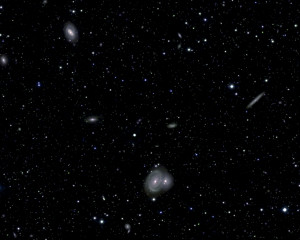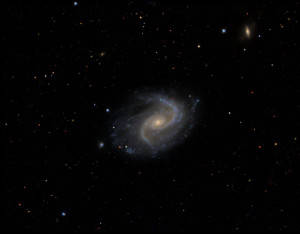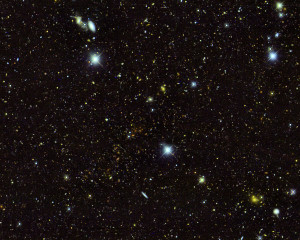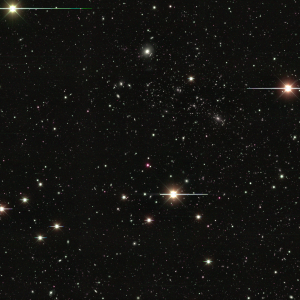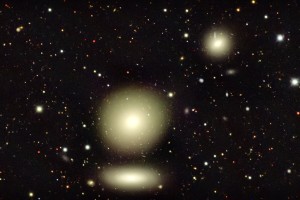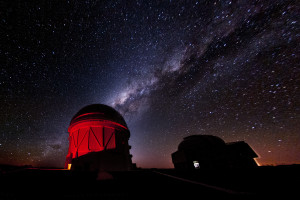With its second year under way, the DES team posts highlights and prepares to release images from its first year
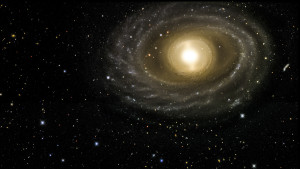
This image of the NGC 1398 galaxy was taken with the Dark Energy Camera. This galaxy lives in the Fornax cluster, roughly 65 million light-years from Earth. It is 135,000 light-years in diameter, just slightly larger than our own Milky Way galaxy, and contains more than 100 billion stars. Credit: Dark Energy Survey.
On Aug. 15, with its successful first season behind it, the Dark Energy Survey (DES) collaboration began its second year of mapping the southern sky in unprecedented detail. Using the Dark Energy Camera, a 570-megapixel imaging device built by the collaboration and mounted on the Victor M. Blanco Telescope in Chile, the survey’s five-year mission is to unravel the fundamental mystery of dark energy and its impact on our universe.
Along the way, the survey will take some of the most breathtaking pictures of the cosmos ever captured. The survey team has announced two ways the public can see the images from the first year.
Today, the Dark Energy Survey relaunched Dark Energy Detectives, its successful photo blog. Once every two weeks during the survey’s second season, a new image or video will be posted to www.darkenergydetectives.org, with an explanation provided by a scientist. During its first year, Dark Energy Detectives drew thousands of readers and followers, including more than 46,000 followers on its Tumblr site.
Starting on Sept. 1, the one-year anniversary of the start of the survey, the data collected by DES in its first season will become freely available to researchers worldwide. The data will be hosted by the National Optical Astronomy Observatory. The Blanco Telescope is hosted at the National Science Foundation’s Cerro Tololo Inter-American Observatory, the southern branch of NOAO.
In addition, the hundreds of thousands of individual images of the sky taken during the first season are being analyzed by thousands of computers at the National Center for Supercomputing Applications at the University of Illinois at Urbana-Champaign, Fermi National Accelerator Laboratory (Fermilab), and Lawrence Berkeley National Laboratory. The processed data will also be released in coming months.
Scientists on the survey will use these images to unravel the secrets of dark energy, the mysterious substance that makes up 70 percent of the mass and energy of the universe. Scientists have theorized that dark energy works in opposition to gravity and is responsible for the accelerating expansion of the universe.
“The first season was a resounding success, and we’ve already captured reams of data that will improve our understanding of the cosmos,” said DES Director Josh Frieman of the U.S. Department of Energy’s Fermi National Accelerator Laboratory and the University of Chicago. “We’re very excited to get the second season under way and continue to probe the mystery of dark energy.”
While results on the survey’s probe of dark energy are still more than a year away, a number of scientific results have already been published based on data collected with the Dark Energy Camera.
The first scientific paper based on Dark Energy Survey data was published in May by a team led by Ohio State University’s Peter Melchior. Using data that the survey team acquired while putting the Dark Energy Camera through its paces, they used a technique called gravitational lensing to determine the masses of clusters of galaxies.
In June, Dark Energy Survey researchers from the University of Portsmouth and their colleagues discovered a rare superluminous supernova in a galaxy 7.8 billion light years away. A group of students from the University of Michigan discovered five new objects in the Kuiper Belt, a region in the outer reaches of our solar system, including one that takes over a thousand years to orbit the Sun.
In February, Dark Energy Survey scientists used the camera to track a potentially hazardous asteroid that approached Earth. The data was used to show that the newly discovered Apollo-class asteroid 2014 BE63 would pose no risk.
Several more results are expected in the coming months, said Gary Bernstein of the University of Pennsylvania, project scientist for the Dark Energy Survey.
The Dark Energy Camera was built and tested at Fermilab. The camera can see light from more than 100,000 galaxies up to 8 billion light-years away in each crystal-clear digital snapshot.
“The Dark Energy Camera has proven to be a tremendous tool, not only for the Dark Energy Survey, but also for other important observations conducted year-round,” said Tom Diehl of Fermilab, operations scientist for the Dark Energy Survey. “The data collected during the survey’s first year — and its next four — will greatly improve our understanding of the way our universe works.”
Visit Dark Energy Detectives, the survey’s photo blog.
Visit DECam Interactive to see what the Dark Energy Camera sees.
Video: Members of the Dark Energy Survey collaboration explain what they hope to learn by studying the southern sky with the world’s most advanced digital camera, mounted on a telescope in Chile.
The Dark Energy Survey Collaboration comprises more than 300 researchers from 25 institutions in six countries. For more information, visit http://www.darkenergysurvey.org.
Fermilab is America’s premier national laboratory for particle physics and accelerator research. A U.S. Department of Energy Office of Science laboratory, Fermilab is located near Chicago, Illinois, and operated under contract by the Fermi Research Alliance, LLC. Visit Fermilab’s website at www.fnal.gov and follow us on Twitter at @FermilabToday.
The DOE Office of Science is the single largest supporter of basic research in the physical sciences in the United States and is working to address some of the most pressing challenges of our time. For more information, please visit science.energy.gov.
The National Optical Astronomy Observatory (NOAO) is operated by the Association of Universities for Research in Astronomy (AURA), Inc., under cooperative agreement with the National Science Foundation.
- The large spiral galaxy in the center of this image is roughly 385 million light-years from Earth. This image was captured with the Dark Energy Camera as part of the first year of the Dark Energy Survey. The camera can see 8 billion light-years into deep space. Photo: Dark Energy Survey.
- Spiral galaxy NGC 0895 is located in the constellation Cetus, about 110 million light-years from Earth. This image was taken with the Dark Energy Camera, the primary research tool of the Dark Energy Survey, which just began its second year of cataloging deep space. Photo: Dark Energy Survey.
- This image captured by the Dark Energy Camera shows the El Gordo galaxy cluster (in the lower right), all that remains of a collision of large-scale structures less than a billion years after the creation of the universe. El Gordo’s mass is roughly the same as the cluster that holds our Milky Way galax, but is more than 100 times hotter. Photo: Dark Energy Survey.
- Composite DECam image (combining images from 4 filters) of the cluster of galaxies RXJ 2248-4431. Bright points with horizontal white lines are stars in our own galaxy.
- The three large objects in this image captured by the Dark Energy Camera are galaxies in the nearby Fornax cluster, roughly 65 million light-years from Earth. The other points of light are also galaxies, much farther away. The Dark Energy Survey will compare patterns in galaxies at different distances from Earth to see how dark energy has affected space-time over the eons. Photo: Dark Energy Survey.
- Stars over the Cerro Tololo Inter-American Observatory in Chile. Credit: Reidar Hahn/Fermilab.




